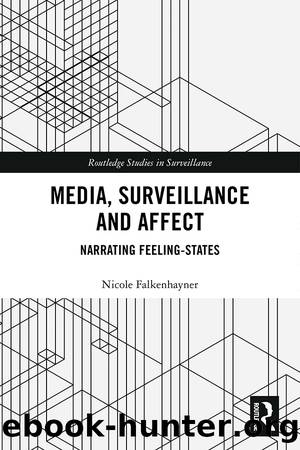Media, Surveillance and Affect by Nicole Falkenhayner

Author:Nicole Falkenhayner [Falkenhayner, Nicole]
Language: eng
Format: epub
Tags: Social Science, General, Sociology, Media Studies, Privacy & Surveillance
ISBN: 9780429880773
Google: owB-DwAAQBAJ
Publisher: Routledge
Published: 2018-12-07T03:44:07+00:00
Concerning movies, Thomas Levin has argued that this last point is a general strategy of more recent Hollywood film narration that became dominant throughout the 1990s â a development that, I argue, has spread throughout the 2000s to other narrative media such as novels and television dramas. This observation presages Patricia Pistersâs remarks on digital screen culture quoted above. Levin argues that this âcinema of âreal timeâ â includes a metaleptic gesture towards the world outside the fictional world. The vivid example Levin uses to illustrate his thesis is taken from a much older movie, Francis Ford Coppolaâs The Conversation (1974), the narrative of which revolves around audio surveillance. But at the end of the film, Levin recounts, the movie camera is transformed into a surveillance camera by performing the typical pan-stop-pan movement around the room as Harry Caul, the filmâs protagonist, desperately searches for the wiretap that he suspects has been planted in his apartment: âSurveillance here has become the formal signature of the filmâs narration.â16
The anxieties and confusion that, following the point of Pisters in the quote above, characterize digital screen culture in general also resonate with these metaleptic gestures. As Kirsten Veel has remarked, surveillance in What Was Lost (2007) appears both as figure and as formal narrative structure.17
Fictional British narratives of the first decade of the twenty-first century that hinge on and express an aesthetic of being captured are innovative not because they speak of surveillance, but because they represent the nucleus of a new way of expressing our relationship to a state of being under surveillance as a naturalized part of contemporary existence. I will use the following heuristics to describe the fiction of capture that I have developed on the basis of a comparison of the features that the three fictions (one movie and two novels) under discussion have in common.
Download
This site does not store any files on its server. We only index and link to content provided by other sites. Please contact the content providers to delete copyright contents if any and email us, we'll remove relevant links or contents immediately.
Cecilia; Or, Memoirs of an Heiress — Volume 1 by Fanny Burney(32377)
Cecilia; Or, Memoirs of an Heiress — Volume 3 by Fanny Burney(31752)
Cecilia; Or, Memoirs of an Heiress — Volume 2 by Fanny Burney(31718)
The Great Music City by Andrea Baker(31087)
We're Going to Need More Wine by Gabrielle Union(18906)
All the Missing Girls by Megan Miranda(15400)
Pimp by Iceberg Slim(14219)
Bombshells: Glamour Girls of a Lifetime by Sullivan Steve(13928)
Talking to Strangers by Malcolm Gladwell(13135)
Norse Mythology by Gaiman Neil(13132)
Fifty Shades Freed by E L James(13123)
For the Love of Europe by Rick Steves(12356)
Crazy Rich Asians by Kevin Kwan(9126)
Mindhunter: Inside the FBI's Elite Serial Crime Unit by John E. Douglas & Mark Olshaker(9107)
The Lost Art of Listening by Michael P. Nichols(7360)
Enlightenment Now: The Case for Reason, Science, Humanism, and Progress by Steven Pinker(7085)
The Four Agreements by Don Miguel Ruiz(6542)
Bad Blood by John Carreyrou(6477)
Weapons of Math Destruction by Cathy O'Neil(6085)
